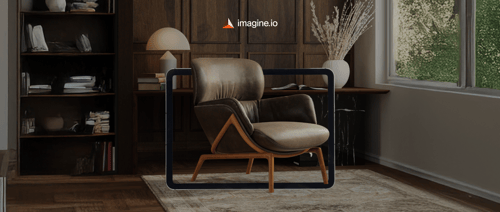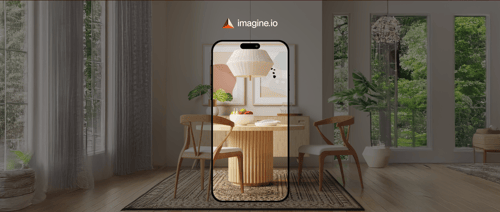Think about your customers’ last online shopping experience — whether they were buying furniture, electronics, or a mattress. They likely scrolled through images, zoomed in, maybe watched a video, and still hesitated. Is the size right? Will it fit their space? Does the material look the same in real life?
That hesitation is where many online sales are lost. This is exactly the gap 3D visualization is designed to close. We’re seeing a clear shift from static product pages to immersive shopping experiences — and businesses that adopt this technology are gaining a competitive edge and improving conversions.
Get the latest updates straight to your inbox.
By clicking sign up you'll receive occasional emails from imagine.io. You always have the choice to unsubscribe within every email you receive.
Static vs. Interactive: A Customer Experience Showdown
Let’s break it down:
- Static Images show a fixed view, often shot in a controlled studio. They’re great for giving a general idea but lack flexibility. A single perspective doesn’t show how the product looks in different contexts or lighting. Customers are left guessing.
- 3D Visualization, on the other hand, allows users to rotate, zoom, swap colors or materials, and even place the product in their own environment (via AR). It gives them agency — and that agency builds trust.
Interactive content dramatically increases dwell time, conversion rates, and overall satisfaction, because people feel like they’ve “seen” the product in the real world.
How 3D Visualization Works
Here’s a simplified but accurate look at the pipeline:
- 3D Modeling: Your physical product is recreated in digital form using 3D design software. This can be based on CAD files, photos, or scans. The goal is to build a model that’s dimensionally accurate.
- Texturing and Materials: The model is enhanced with surface details — think wood grains, fabric textures, or metallic finishes. Lighting and shadows are simulated to create a photo-real feel.
- Rendering or Real-Time Display: The model is either rendered into 2D images (for product pages or ads) or displayed as an interactive 3D viewer where users can explore it in real time.
- Deployment: These assets are embedded across websites, eCommerce platforms, AR experiences, and even sales tools.
Platforms like imagine.io automate much of this, offering tools that let non-technical teams produce, manage, and deploy these assets at scale.
Business Benefits of 3D Visualization
-
Cost Efficiency Without Compromising Quality
Traditional product photoshoots involve logistics, props, shipping, and studio costs — all multiplied by the number of product variants. A single product with 5 colors and 3 styles may require 15 separate shoots. With 3D, you create one model and swap variables digitally. Brands save 60–80% on content production over time.
-
Faster Time-to-Market
Need a new product page in three days instead of three weeks? With 3D visualization, that’s possible. As soon as the 3D model is ready, you can generate all the images, spins, and lifestyle renders you need instantly.
This is crucial for brands launching seasonal collections, responding to market trends, or building personalized experiences on demand.
-
Increased Conversions Through Immersive Experience
3D visuals help customers feel confident about their purchase. They can inspect a chair’s fabric, see how a mattress fits in their bedroom, or understand how a gadget folds and connects — all before they buy.
This confidence directly impacts sales. Around 34% of users communicate with 3D content for 30 seconds or more.
-
Lower Returns and Happier Customers
When a customer sees exactly what they’re buying — from all angles, in multiple styles — there’s less room for surprise or disappointment. That means fewer returns, which saves money and improves customer satisfaction.
In fact, a study by Deloitte found that returns dropped by up to 40% for brands implementing 3D and AR tech.
3D Visualization Use Cases by Industry: How Leading Brands Are Doing It Right
-
Furniture and Home Décor
A chair isn’t just a chair — it’s a design decision. With 3D visualization, users can rotate it, test different colors and fabrics, and even see how it looks beside their sofa. Brands like Wayfair, IKEA, and Burrow are leading the charge.
IKEA pioneered AR visualization through its app, allowing customers to place true-to-scale furniture in their space — resulting in more confident purchases. Burrow, a DTC brand, uses 3D to render all their modular sofa configurations, saving massively on photoshoot costs while offering a personalized shopping experience.
-
Fashion and Footwear
Customization is key in fashion. Nike and Adidas let customers design and preview sneakers in 3D, creating fun, immersive experiences that lead to longer site visits and higher cart values.
For instance, Nike's revenue grew from $36.4 billion to $46.7 billion over a four-year span, a growth partially attributed to innovations like 3D customization
-
Consumer Electronics
For gadgets and tech products, customers want to explore ports, hinges, dimensions, and screen angles. 3D brings spec sheets to life through fully explorable product demos — turning passive browsing into active engagement.
-
Beauty and Packaging
Cosmetic brands use 3D for bottle renders, package testing, and virtual tours. It's especially valuable for pre-launch campaigns where physical packaging isn’t yet ready, helping brands visualize and market products faster.
-
Mattresses and Textiles
This is where platforms like imagine.io shine. Businesses can showcase mattress layers, adjust firmness levels, and place products in stylish bedroom scenes — all without a single studio shoot. It’s a game-changer for cost, speed, and customization.
The Role of 3D in B2B Commerce
This isn’t just for B2C brands.
- For Distributors and Retailers
Retailers often need hundreds of product SKUs with variants. 3D makes it easy to generate localized visuals, update styles, or visualize collections for buyers — without reshooting.
-
For Sales Teams
Imagine showing up to a meeting with an interactive product catalog on your iPad, letting buyers explore configurations on the spot. That’s a game-changer.
-
For Product Development
3D models allow internal teams to prototype faster, share visual concepts with partners, and align across geographies without shipping a single sample.
How imagine.io Fits Into the Picture
imagine.io is a visual content creation platform that helps brands turn physical products into stunning, customizable, digital experiences. It’s designed specifically for:
- Furniture, mattress, home, and décor brands
- Teams that need high-quality visuals fast
- Businesses that want to scale without burning money on shoots
With drag-and-drop product builders, auto-generated lifestyle scenes, and cloud asset management — imagine.io empowers brands to do more with less. And because it’s no-code, you don’t need to be a 3D expert to get started.
Future Trends in 3D eCommerce
What’s next?
- Real-time customization with AI-generated recommendations
- 3D social commerce integrations (Instagram, TikTok, Pinterest)
- Virtual stores with immersive 3D environments
- Full digital twins — combining 3D visuals with data for end-to-end tracking
- Voice + AR shopping assistants
The brands preparing for these shifts now will lead the next generation of digital commerce.
Final Thoughts
3D visualization isn’t a trend — it’s a turning point. It’s how modern brands are creating experiences that feel real, personal, and confident. And for businesses competing on speed, scale, and digital reach, it’s the smartest tool in the kit.
If you’re ready to reduce costs, accelerate time-to-market, and give your customers an experience they’ll remember — it’s time to go from static to interactive. And with platforms like imagine.io, the transformation starts today. Want to know more? Book a demo with our experts today.


.gif?width=1296&height=1296&name=Untitled%20design%20(8).gif)



.png?width=500&name=How%20to%20Add%20a%203D%20Product%20Configurator%20to%20Your%20WordPress%20Website%20(Complete%20B2B%20Guide).png)
















%20(1).png?width=500&name=Why%20Exploded%20Mattress%20Views%20Matter%20(And%20How%20to%20Generate%20Them)%20(1).png)
.png?width=500&name=Best%20Shopify%20Product%20Configurator_%20How%20to%20Choose%20the%20Right%20One%20(2).png)
.png?width=500&name=Why%20Exploded%20Mattress%20Views%20Matter%20(And%20How%20to%20Generate%20Them).png)



.png?width=500&name=Best%20Shopify%20Product%20Configurator_%20How%20to%20Choose%20the%20Right%20One%20(1).png)







.png?width=500&name=How%203D%20Rendering%20Can%20Make%20or%20Break%20Your%20Industrial%20Design%20Pitch%20(1).png)








%20with%20Digital%20Twins%20and%203D%20Visualization.png?width=500&name=Optimizing%20Your%20Digital%20Asset%20Management%20(DAM)%20with%20Digital%20Twins%20and%203D%20Visualization.png)




.png?width=500&name=Styling%20Home%20Decor%20for%202025_%20From%20Global%20Influences%20to%20Playful%20Personalization%20(1).png)

